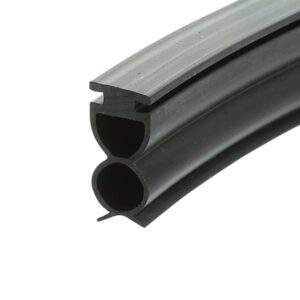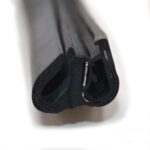Rubber sealing strips are essential in automotive, window & door, appliance, and industrial applications. EPDM and Neoprene are two of the most popular synthetic rubbers, each offering unique advantages. This guide compares them across key factors—physical properties, temperature limits, chemical resistance, cost, and typical uses—to help you select the right material for your project.
Material Overview
| Property | EPDM (Ethylene Propylene Diene Monomer) | Neoprene (Polychloroprene) |
| Composition | Ethylene, propylene, non‑conjugated diene | Polymerized chloroprene |
| Temperature Range | –50 °C to 150 °C | –60 °C to 120 °C |
| Weather & Ozone Resistance | Excellent | Good |
| Oil & Chemical Resistance | Poor (swells in oils/solvents) | Excellent |
| Elastic Recovery | Up to 600 % elongation | Up to 1000 % elongation |
| Typical Hardness (Shore A) | 60–90 | 50–80 |
| Cost | Lower | Higher |
Key Differences
1. Physical & Mechanical Properties

- EPDM: Outstanding UV, ozone, and weather resistance—ideal for outdoor seals (doors, windows, marine).
- Neoprene: Superior resistance to oils, acids, and chemicals—perfect for engine bays, chemical equipment.
- Both: High tensile strength (500–3000 PSI), good tear and abrasion resistance.
2. Temperature Resistance
- EPDM: –50 °C to 150 °C; suited for extreme heat, steam, and cold.
- Neoprene: –60 °C to 120 °C; better low‑temperature flexibility, slightly lower heat tolerance.
3. Chemical & Oil Resistance
- EPDM: Not recommended for oil‑exposed applications (swelling).
- Neoprene: Excellent resistance to oils, fuels, acids, and alkalis.
4. Cost & Value
- EPDM: Cost‑effective for high‑volume, general‑purpose sealing strips.
- Neoprene: Higher unit cost but justified where chemical resistance is critical.
Typical Applications
| Application | Recommended Material | Key Benefit |
| Window & Door Weatherstripping | EPDM | UV/weather resistance, noise reduction |
| Automotive Engine Seals | Neoprene | Oil and chemical resistance |
| Appliance Gaskets | EPDM or Neoprene | Choose based on heat vs. chemical needs |
| Marine Seals | EPDM | Saltwater and weather durability |
| Chemical Processing Equipment | Neoprene | Acid/alkali and solvent resistance |
| General Industrial Seals | EPDM | High value, versatile performance |
How to Choose

- Environment: Outdoor/UV exposure → EPDM; Oil/chemical exposure → Neoprene.
- Temperature: Above 120 °C → EPDM; Below –50 °C → Neoprene.
- Budget & Volume: High volume, tight budget → EPDM; Performance‑critical → Neoprene.
- Customization: Both materials support custom cross‑sections, co‑extrusion, and flocking.
Conclusion & Next Steps
There is no universally “better” material—only the right one for your application. EPDM excels at weather and temperature resistance; Neoprene shines in oil and chemical environments. Define your operating conditions, then choose accordingly.
Contact OKIN for expert guidance, fast prototyping, and global delivery of custom rubber sealing solutions!
